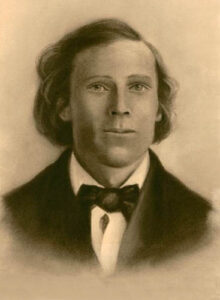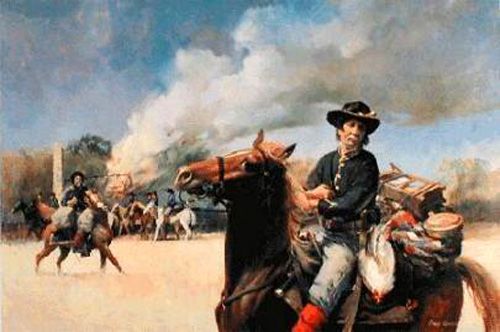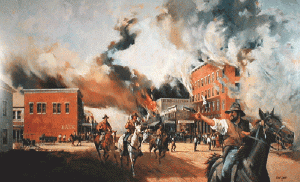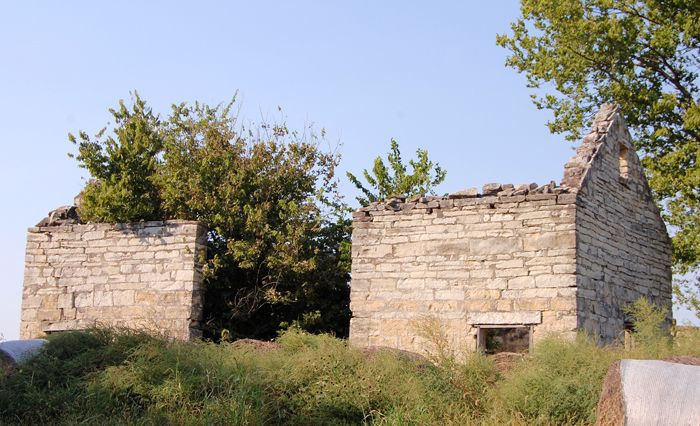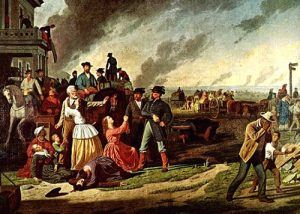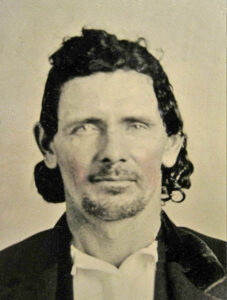Richard Francis Yeager, better known as Dick, was a Confederate guerilla who joined up with William Quantrill during the Civil War. He is known for a daring raid near Council Grove, Kansas, on May 4, 1863, and was part of Quantrill’s raid on Lawrence, Kansas, on August 21, 1863.
Richard was born to James Barnes Yeager and Mary Jane Berry Yeager on March 28, 1839. His father served in the state legislature for two years and was the Jackson County, Missouri, Court presiding judge in 1840. He also owned a freighting business between Missouri and New Mexico along the Santa Fe Trail.
During the early part of the Civil War, Dick was leading one of his father’s wagon trains. Upon returning home, he found that Charles Jennison’s Redlegs, a Union guerilla unit from Kansas, had come to his father’s farm, stripped it of everything they could carry off, and Judge Barnes Yeager had been temporarily arrested. Dick immediately quit the freighting business and joined Quantrill’s Raiders in the Confederate cause.
During the Border Wars, Yeager’s name graced headlines across the country as a tyrant torturing Kansas towns. He sacked Shawnee and Blackjack and was present at the Lawrence Massacre. At just 25 years old, Dick had developed quite a reputation.
Holding a field commission under the Partisan Ranger Act, William Quantrill and his Confederate guerrillas perfected military tactics, coordinated and synchronized attacks, and utilized preplanned routes and relays of horses. The group ambushed Union patrols and supply convoys, seized the mail, and occasionally struck towns on both sides of the Kansas-Missouri border.
Yeager soon led a gang of guerillas, sometimes called the Hays Gang. Yeager’s first raid into Kansas occurred in late October 1861, when he and 13 others, including Cole Younger, invaded the town of Gardner in Johnson County, Kansas, brandishing double-barreled shotguns. No one was injured, nor were the bushwhackers successful in their attempt to rob a store.
Reflecting the destructive nature of the guerrilla conflict in Missouri, Quantrill directed much of his effort against pro-Union civilians as well as attacking Jayhawkers, Missouri State Militia, and Union troops primarily relying on ambush and raids. Yeager was listed on a muster roll containing 92 names of William Quantrill’s men. Union troops found the muster roll on one of the dead Missouri Partisan Rangers after the Battle at Pleasant Hill, Missouri, on July 11, 1862.
On May 4, 1863, Dick Yeager and his band of 23 guerrillas encamped on land owned by General George Armstrong Custer in the Council Grove area. Planning to sack the town, he found that the citizens had armed themselves and posted sentinels each night, frustrating his plans. However, they continued domineering over the citizens for some time with a high hand and using threats and insults.
The next morning, Yeager and a companion rode into town and straight to the office of Dr. J.H. Bradford, a fellow Missourian who knew Yeager as a Santa Fe Trail freighter. Once inside, Yeager spoke to the dentist: “Doctor, I expect that you know me, but I have a tooth that aches like hell, and if you give me relief, I will be good. But if we are bothered by any movement on the part of your Unionists, we will burn the old town before we leave, for that is what we came for.” Bradford pulled the offending tooth and gave Yeager a bottle of pain-killing laudanum. To Council Grove’s relief, the town be spared.
His band rode west to Diamond Springs, Kansas, where they attacked the stage station on May 5, 1863. During the raid, the station manager, Augustus Howell, was killed, and his wife, Sarah, was severely wounded. The renegades then set the station on fire and fled east. The raiders stayed in the area another day or two before heading back to Missouri. On the way, they killed a Union soldier at the Rock Springs stage station and robbed a stagecoach near Black Jack.
The Diamond Springs stage station was never rebuilt and moved to Six Mile Creek, so named for its distance from Diamond Springs. The spring, however, continued to be a valuable water source and popular campsite as long as the Santa Fe Trail was active in the area.
“I went up to the falls [Cottonwood Falls] and over to Bazaar after a band of gorillas got back about two o’clock in the afternoon. Jo Randolph and Charles Bundren came with me. The guerillas that Mardin was helping to track were Confederate sympathizers led by Richard Francis Yeager, one of William Clark Quantrill’s captains.”
— Elisha Mardin, who owned and operated the second-largest ranch in Chase County, May 8, 1863.
Union authorities had fixated on finding and killing Yeager that summer after they erroneously assumed Yeager had led the early May 1863 raid deep into east-central Kansas by the small band of Kansas exile guerrillas. It appears that Yeager used his prewar freighting experience in Kansas to guide this guerrilla raid, but he did not lead it. The Federals had faulty intelligence about the true leadership of several of the west-central Missouri guerrilla bands. William Quantrill may have used this May raid as the inspiration for his better-known Lawrence Massacre in August 1863.
The Confederate government, which had granted Quantrill a field commission under the Partisan Ranger Act, was outraged and withdrew support for such irregular forces. By 1864, Quantrill had lost control of the group, which split up into small bands.
By the fall of 1863, Union soldiers were on guard and had the eastern border of Kansas so well covered that the Confederate guerilla raids virtually stopped.
As early as June 1864, it was reported by Union soldiers that Dick Yeager had been killed near the Jackson/Lafayette County border, and the news spread like wildfire, but it wasn’t true.
On July 20, 1864, Confederate guerillas, under George Todd’s leadership, attacked the Arrow Rock Federal troops of the 1st Cavalry in Saline County, Missouri. During the raid, Yeager suffered a head wound, and two doctors examined the wounds and “thought they were of such character he could not recover, his brains exuding from two places.”
However, George Todd took him in an ambulance to a location about seven miles from Miami, Missouri. He was placed in a safe house with the Flannery family, who had been exiled from the General Order Number 11 region near New Franklin, Missouri. Though he was carefully nursed, he died on August 1, 1864. He was buried in the Forest Hill Cemetery in Kansas City, Missouri.
The Union soldiers did not realize who they had killed until a few days later. When newspapers reported the killing in early August 1864 of his death in Arrow Rock, the headlines read, “Dick Yeager Killed Again.”
Jennie Flannery testified that she had nursed Yeager, and she was sent to prison for this offense.
A few years after the Civil War had ended, a tremendously scarred Lawrence built Kansas University, and the Jayhawker was chosen as their mascot to ensure that the men whose blood was shed for their free-state ideals would never be forgotten.
© Kathy Alexander/Legends of America, February 2024.
Also See:
Death & Dying in the Civil War
William Quantrill- Renegade Confederate Leader
Sources:
Find a Grave
Gardner News
Hickman, W.Z, History of Jackson County, Missouri, Historical Publishing Company, 1920
Hoy, Jim; Yeager’s Raiders, Symphony in the Flint Hills Field Journal, 2016
New Santa Fe Trail Blogspot
Quantrills Guerrillas

